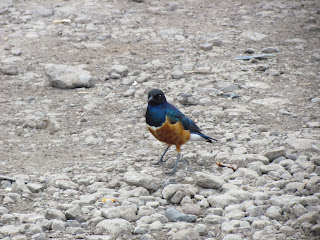For environmental policy, we headed out to a group ranch where agriculture is the main source of livelihood on this communal land. Our assignment consisted of interviewing local Maasai people living on this ranch via a translator in order to gain greater perspectives on human-wildlife conflicts.
We walked through several miles of farmland at the foothills of Mt. Kilimanjaro, which extended as far as we could see. Stopping at three bomas, we interviewed neighbors who all expressed that they needed more help from the government in terms of compensation for crop damage by wildlife, such as elephants and monkeys. They said that a warden from Kenya Wildlife Services comes once per week for free to watch over the crops at night, but this leaves the majority of the time for wildlife to raid crops. The people are frustrated and view the wildlife as a big problem. They can’t kill the wildlife because they will be fined immensely, but they throw rocks at them to try to get them to leave and attack them with spears. They also kept asking us for money and food, and were surpsrised that we didn’t even have some chai (tea) with us to give them. It’s unfortunate that whenever you try to talk to someone here to get to know them they start asking you for money or your watch.
After several interviews, we realized that everyone was saying the same thing and expressing the same problem in terms of lack of governmental assistance and a major conflict and thus distrust/lack of care for the wildlife. As a result there are serious wildlife conservation issues in the area, such that the local people rely on wildlife tourism to support their communities, yet they do not reap significant economic benefits from it, only the national government. Therefore, they do very little to protect the wildlife here.
When we got bored of interviewing we helped one man weed his onion crops. It was around 90 degrees in full sun and I couldn’t believe he was wearing a winter hat. We lasted about ten minutes before we got too hot and tired. It’s really hard work!
On the way home in the Land Cruiser, we were waving to the little kids as usual and heading back to camp for lunch. All of a sudden, the student sitting next to me in the back row of the car saw a hand reach in the window, followed by a little boy falling off the back of the vehicle. He was actually trying to hang on to the Land Cruiser over the extremely bumpy dirt roads and fast speeds on the paved infrastructures. I was shocked that he tried to do that!! He wasn’t hurt but I’m amazed at the lengths these people will go to in order to get a ride here. They pack into the vans here like sardines, so that some are literally standing on top of each other. I will never complain about the subway being packed again having seen this comparison.
Tomorrow is non-program day so I’m excited to see what the Kenyan market is like! We’re also supposed to visit an AIDS support group so I’m really looking forward to it!

























